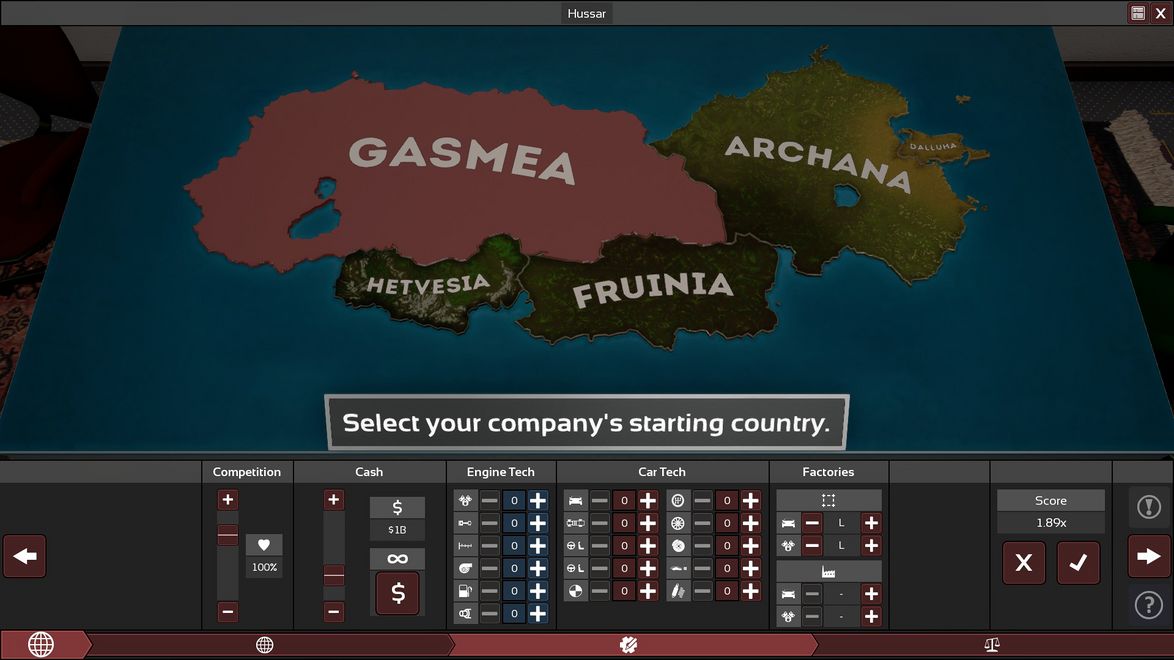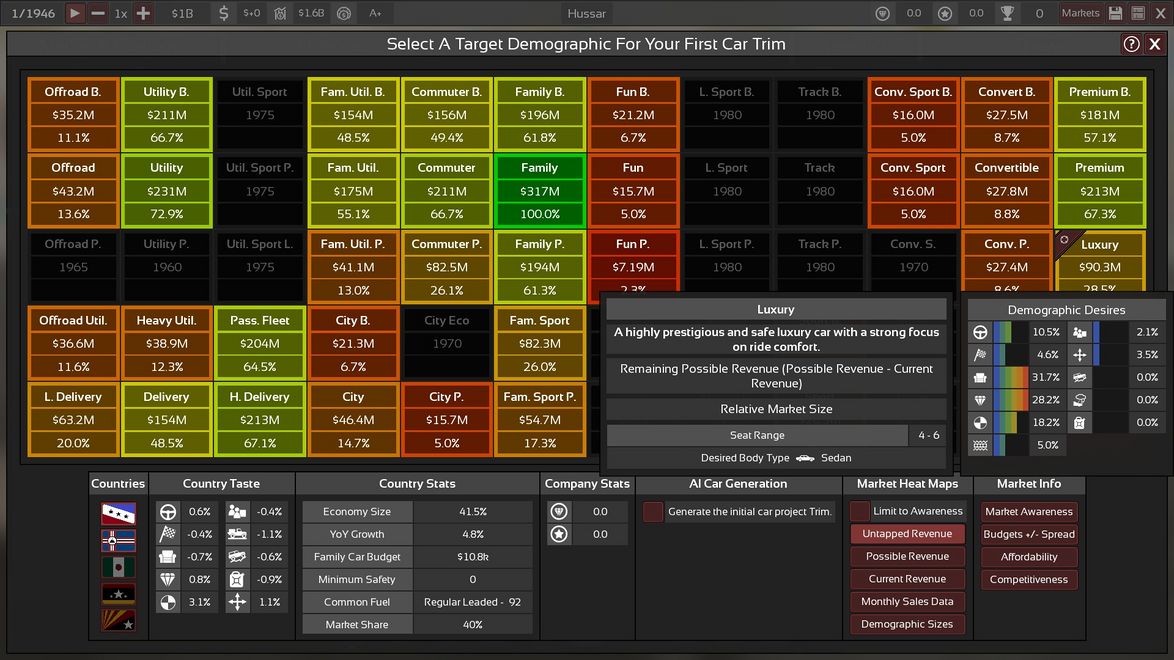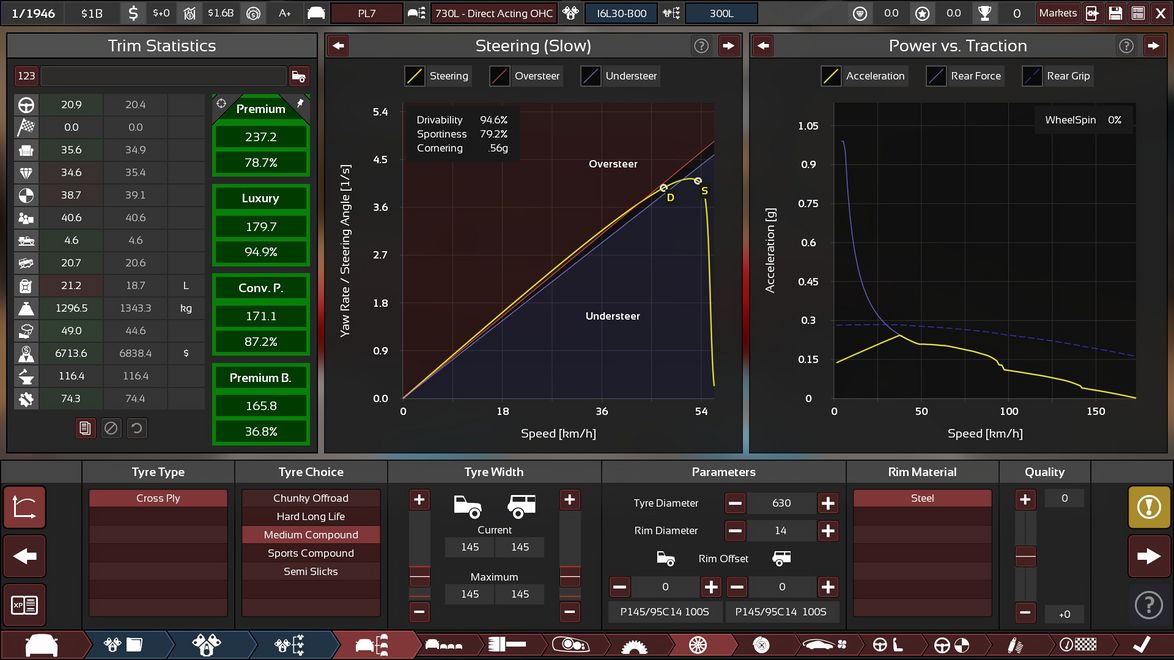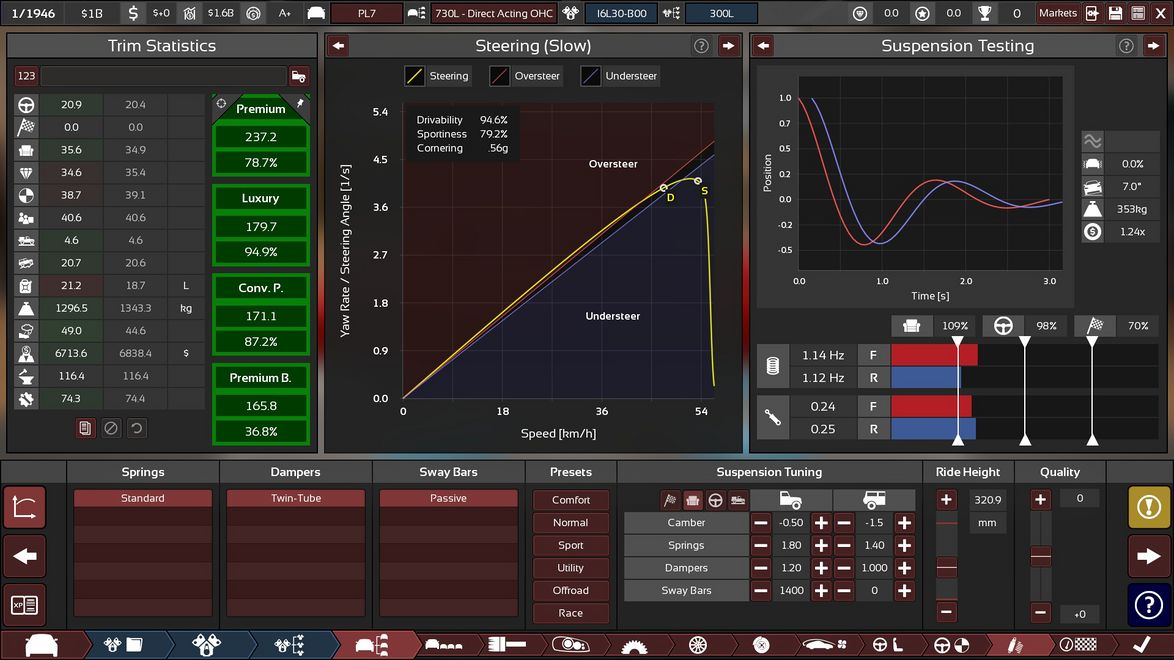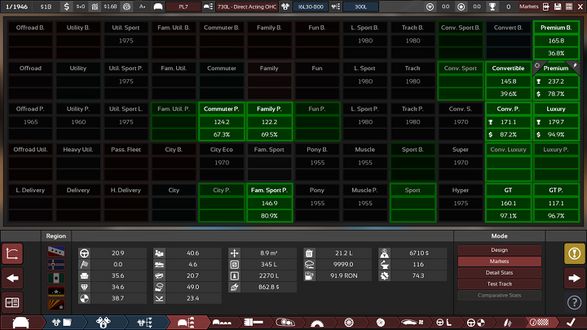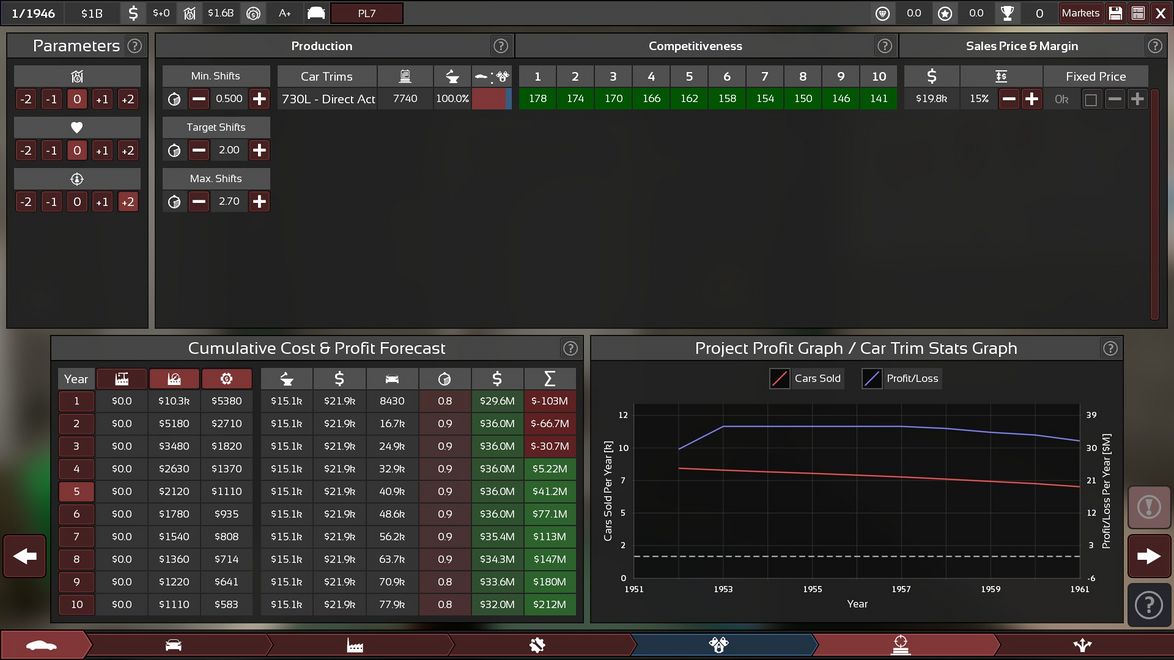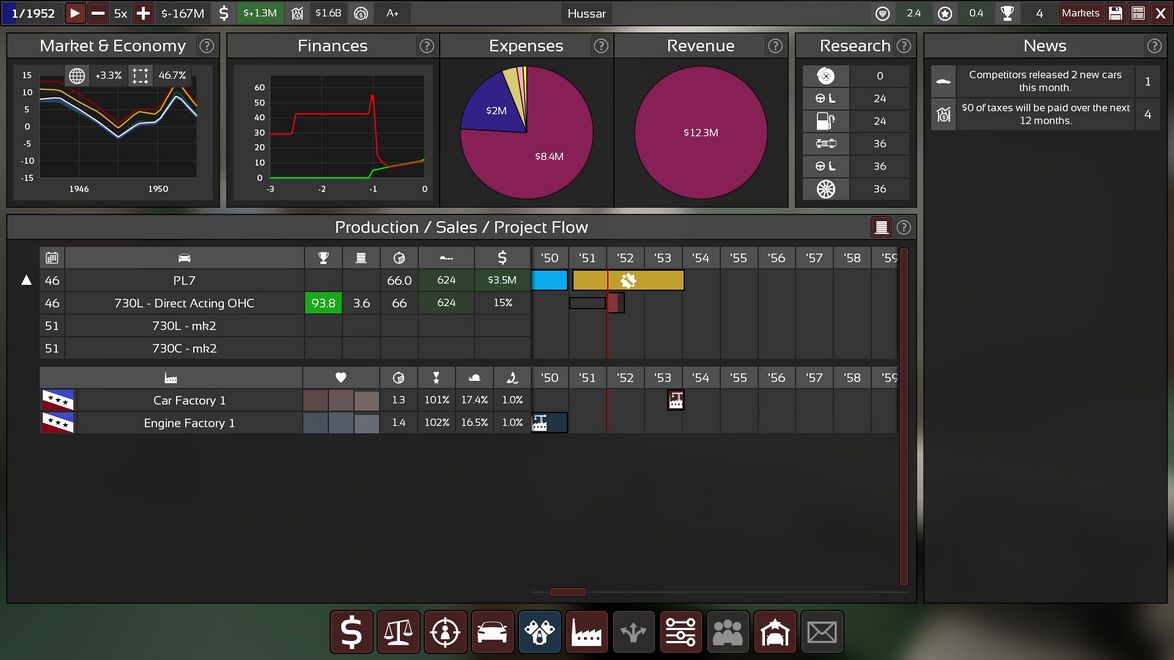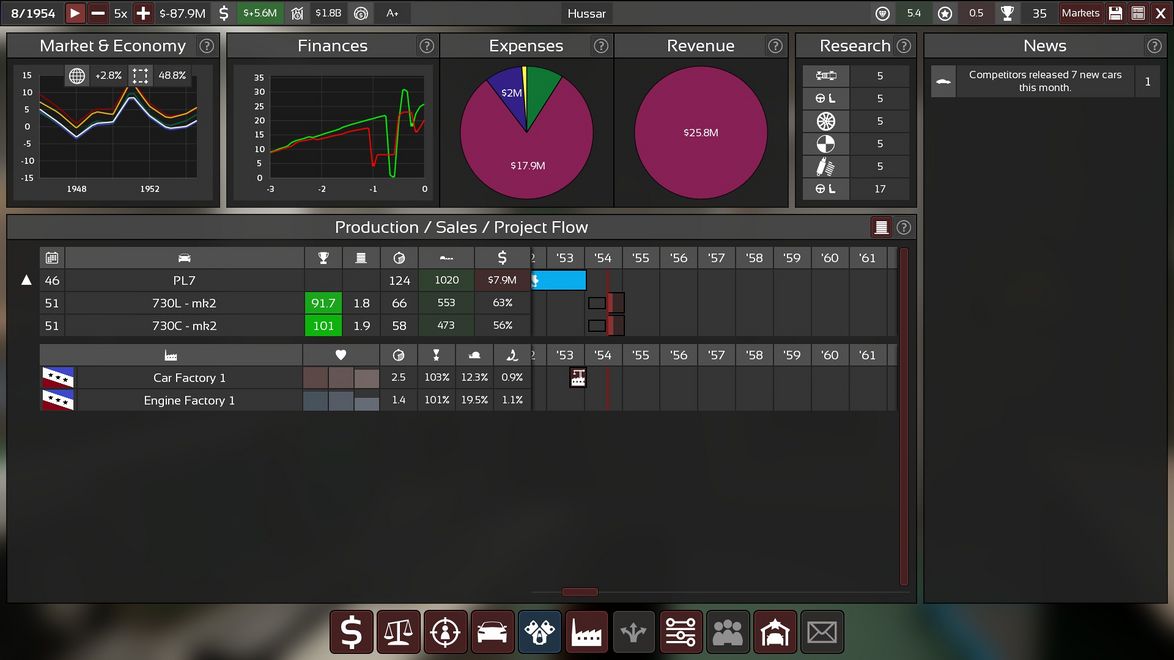Introduction
| File:Information icon.svg | This content refers to the 4.0 version of the game and might not be accurate for different versions. |
This tutorial is targeted to new players, to help them get started with the campaign and specifically not going bankrupt after releasing the first car.
Overview
Starting with a luxury car can be considered easier for a couple of reasons. First of all, there are fewer choices. In many cases in the top segments options are naturally getting limited, as the best components are the way to go. For example while lower segments there might be some pros and cons for picking a smaller or larger body type, for a luxury car just pick the largest available body. As this limits the available options, it makes the job easier. Another argument in favour of this kind of start is that those markets are not that much price sensitive so there is also a larger room for error.
Once you have successfully designed your first luxury car, you made yourself familiar with the basics of setting up factories and sales model, this first car will be your solid source of income. With this ground work you will be able to experiment expanding to different segments without the gloom of impending bankruptcy.
Campaign setup
After selecting the name of your company, the next choice is the difficulty level. I recommend instead of picking one of the predefined pressets, to customize the difficulty via advanced settings.
Starting country
For the luxury brand the best starting place is either Gasmea or Hetvesia, as they are two largest markets for comfortable cars and their markets are opened to one another from the beginning. If you picked Fruinia for example, you would not be able to sell your cars to Gasmea from the start.
Adjusting difficulty level
Highly recommended is to pick Large or Huge starting factories plot sizes with no pre-built factories. If you start with some pre-existing factories you might end up in a situation where your engine or car factory will be too large and will generate too high costs. It is better to start with a larger pile of cash and build factories with the exact size you need.
Things are a bit different with the starting plots. The larger starting plots you have, the higher your company evaluation is going to be, increasing your credit score and allowing for larger loans, without handicapping your profits.
For this playthrough I have selected the following settings:
- Competition: 100%
- Cash: $1 Billion
- Engine/Car Tech: 0
- Factories plots: L
- Factories: -
- Home Country Dealership Network: Level 3
- Other Country Dealership Network: Level 1
Feel free to add a couple of hundreds millions more if you want an easier start, or decrease the competition to 80% or 90% if you want easier playthrough later on.
First car
When prompted, select that you will design your first car on your own. Choose Premium or Luxury as the target demographic. Note that the demographic sizes might vary from game to game.
General process should look like you first select some sensible defaults and then go back and start fine tuning your design. Initially it’s also the best to avoid fiddling with the quality sliders and keep them at zero.
Body
This is simple. Select the largest available four door saloon body (3.1 meters wheelbase).
Chassis
For materials pick steel. High end demographics do not care if the car will turn into rust :) Chassis type space frame (switch to monocoque once it will become available in the future). Engine placement Front Longitudinal and suspension Double Wishbone front & rear are solid choices throughout the game and the best early on for this segment.
Engine
Luxury/Premium buyers want smooth, quiet and prestigious engines. Keep in mind it should be rather low revving, plenty of torque, with limiting exhaust (to keep it quiet) and power doesn’t matter that much. Good choice will be a 3 litter Inline 6, with Direct Acting OHC (to make it cheap) making around 100-120hp. There is a more detailed tutorial about engine selection for this car.
Trim body selection
Pick a four doors sedan.
Drivetrain
Longitudinal RWD. At the campaign beginning you are limited to a manual gearbox, so there is no other option. Switch to automatic as soon as it becomes available. Top Speed should be aligned with what the engine allows.
Gearbox spacing and number of ratios should make sure that there is no wheel spin, but adjust that at the end, after selecting tyres width and suspension tuning.
Wheels and Tyres
Medium Compound is the most comfortable. Regarding tyre and rim dimensions: don’t go crazy. Keep it sensible (or stick with the default values) initially and come back here for fine tuning later.
Brakes
Early on just go for the largest brakes possible and comfortable Pad Type. During fine tuning keep decreasing the Pad Type as long as the car’s score is increasing.
Aerodynamics
Leave it untouched.
Interior
Two seats at front, two seats back. That’s what the market wants.
After the engine, here we have the first trade off to choose. For the Luxury demographic “Hand Made” Interior and “Luxury AM Radio” will be the best, while it is going to be a bit too costly for the Premium demographic. As initially we can not afford having two different trims or models, you can make a compromise and pick “Hand Made” Interior with “Premium AM Radio” in order to cover both of those markets.
Later in the game you might revisit this decision. For “Luxury/GT/GT Premium” trims just go with the best option available.
Safety and Driving Aids
For the Premium/Luxury demographics, always pick the best and the latest here.
Suspension
Initially there is not much choice. Later in the game pick the most comfortable options.
Select the “Comfort” Presets and start the fine tuning process.
Fine tuning
After making the initial selections now it’s time to go back and start fine tuning it.
First go back to tyres and pick tyre widths that will have a drivability score of 90%-100% (100% is the best for the target demographics) either without the terminal oversteer, or almost without the terminal oversteer. The thing is that you can later tweak this a little bit by tuning suspension, but tyre sizes are making the largest impact - if you have too much terminal oversteer, you won’t be able to correct it via the suspension tuning.
Next go to the Suspension Tuning, and try to maximize your car’s desirability.
Once those steps are done, and the basic handling characteristics of your car are set, go back and fine tune brakes sizes, pad types, brake bias and gearbox spacing.
Lastly you can also fine tune your engine (increase smoothness and make it quieter), but keep in mind changes to the power output can force you to change the gearing and changes to the weight of the engine can affect handling and require suspension tuning.
Summary
At the end you should have a very highly desirable and affordable car by various segments, mainly Premium, Luxury, GT. Keep in mind that the market scores at this stage are pre-production values, ignoring factories and engineering. Final scores will be much lower :(
Factories and Engineering
The general idea is that you should pick the factory sizes based on the expected sales and you should aim for 100% to 200% factory utilisation (1.0 to 2.0 shifts). Sales prediction can help you with making this decision, as well as your historical sales figures. However if you are entering completely new markets/demographics, and you don’t have the market awareness you are forced to take educated guesses. The biggest problem is with various limitations of the sales forecast. As you will be forced to go through a trial and error method, saving the game before signing off the project is always a good idea.
To save you some troubles, for this tutorial start with Medium 1 car factory for your single trim and Small 3 for it’s engine.
Car Factory
Medium 1 factory size. If you picked “Hand Made Interior”, it’s a good idea to have “Leatherworks” Factory Add-On and you need “Steel Presses” as well.
For the time being I recommend leaving other options at the default values.
Car Engineering
Aim for 60 months engineering time. If the engineering takes longer, first increase Funding to 100%, next you can bump the Pressure or decrease the Tooling/Process/Reliability. Keep in mind that Luxury and Premium demographics do not care about reliability, while Tooling and Process will affect the final car price and cut into your profit margins.
Engine Factory
Small 3 factory size. Other options keep default.
Engine Engineering
Again aim for 60 months and make sure that both car and engine projects are aligned. If one is ahead of the other, decrease Pressure (to acquire more familiarity) or increase Process/Tooling to decrease unit costs.
At the end, in the “Cumulative Cost”, remember to deselect “Factory Cost Inclusion” in the engine price. Factory will stay with you forever, so it doesn’t make much sense to include it’s cost in the unit price of the engine. Re-tooling and engineering costs on the other hand should be included.
Profit Forecast
Set minimum profit margin between 10% and 20%. As explained above, with the initial (no) market awareness the Profit Forecast is pretty useless. Later when you are going to be designing replacement models, it will be more useful.
Overview
On the last page make sure that everything is right. In particular pay attention whether:
- Car and Engine engineering times are aligned
- Engine factory has matching load with the car factory
Finally save the game and sign of the project. If you lack the funds to finance the project, you can activate a loan. As for Automation 4.0, you can safely go to negative cash balance to some extent. For example with company evaluation of $1B, it’s safe to have -$200M cash.
Now you can also see your car’s final scores. In my example they went down from ~233 to ~179. Score of 100 means “market average”, so you should be aiming above that. Anything above 150 is very good and you should be dominating the market.
Marketing
After signing off, speed up the clock and wait for your car to finish engineering. Right about when your factories are going to be building/retooling is a time to think about marketing and dealership networks.
Invest a couple of points in marketing (Comfort and Prestige) on your main markets (Gasmea and Hetvesia).
Also start increasing dealership networks in your non-home market (Hetvesia if you are based in Gasmea or the other way around). This also depends on your starting setting, but regardless of it try to aim at the level 2 or 3 in each for the model roll out. This is because your market awareness will shoot up after the release and if you hit the market awareness cap you are basically losing sales opportunities.
Release
As you are approaching the release, slow down the time. Hopefully you didn’t go bankrupt until the release. If this happened either reload and tweek something, or increase starting cash.
Couple of the first months after the release are going to be rough. You will be heavily restricted by the market awareness, prices are going to be still fluctuating and adjusting. However after a couple of months you should reach or almost reach profitability.
But don’t waste this time staring at the financial chart!
Facelift
Almost immediately (not later than a couple of months) after the release, start a new face lift of your model.
Mk2
By this time (~1951) you should have enabled a couple of new crucial technologies. Automatic transmission and Advanced 50s safety. Pick those and fine tune your gearing. Since those will be the only changes, you probably don't need to fine tune other things.
If you struggle with money, don’t modify your engine to avoid Engine factory retooling costs.
Second trim
Based on your first Luxury/Premium sedan, there are two good options for adding a new trim: Convertible Premium/Luxury or GT/GT Premium. Based on the market sizes pick one. Convertible is probably a more sensible option, since your Luxury Sedan should be covering GT market pretty well (sedan body type penalty for GT is smaller compared to lack of convertible body type).
Clone your first facelifted (Mk2) trim and select the desired trim body. When going from Premium Sedan to Convertible Premium or GT there are very few things that need to change. Also the fewer changes you make, the cheaper and faster will be the engineering. In this example I have just selected the four door convertible body and adjusted suspension.
Engineering
Select the same factories as for the Mk1. Engineering time should be quick (~36 months) limited by Safety and Drivetrain changes. You can use this to optimise the Process in order to increase the profit margins.
Mk2 Release
Wait for the facelift to finish engineering. During this time you should be making enough money to cover the facelift costs and the revenues should be steadily rising as your market awareness grows.
Upon the Mk2 Release, you should have enough profits and high enough company evaluation, that you can start expanding.
Next steps
First order of business is to check when is going to be available the next big saloon body for your Premium/Luxury model replacement and start engineering as soon as you can to keep your competitiveness.
Next you can think about expanding your model range. Those are a couple of options, amongst many:
- Sport or other “Premium” markets car sharing 6 cylinder engine family
- Move your main model (or trim?) down the range to make room for a true Luxury/Luxury Premium car with a V12.
In the long term all of the Premium/Luxury markets can be the backbone of your company sharing the same engines and leveraging engineering familiarity for the same components.
